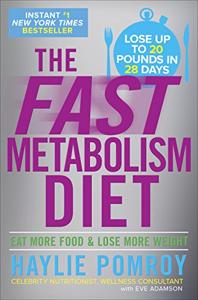
Want to learn the ideas in The Fast Metabolism Diet better than ever? Read the world’s #1 book summary of The Fast Metabolism Diet by Haylie Pomroy here.
Read a brief 1-Page Summary or watch video summaries curated by our expert team. Note: this book guide is not affiliated with or endorsed by the publisher or author, and we always encourage you to purchase and read the full book.
Video Summaries of The Fast Metabolism Diet
We’ve scoured the Internet for the very best videos on The Fast Metabolism Diet, from high-quality videos summaries to interviews or commentary by Haylie Pomroy.
1-Page Summary of The Fast Metabolism Diet
Overview
The Fast Metabolism Diet is a book about Haylie Pomroy’s dieting program. It was developed to repair dysfunctional metabolic processes and make the body more likely to burn food as fuel rather than store it as fat. Many chronic dieters damage their metabolisms by restricting calorie intake, causing stress on the metabolism. When the brain believes that the restricted diet is caused by danger or scarcity in the environment, it naturally shifts resources to store more food as fat in case of famine. When heavy exercise is added to this restrictive diet, then your body produces more stress related hormones and decides to consume muscles for fuel rather than available fat as it normally would.
The Fast Metabolism Diet has a few simple rules to help people lose weight. The first rule is that dieters should eat something within 30 minutes of waking up. Another rule is that they shouldn’t consume processed foods or added sugars, and they should reduce stress routinely. The diet lasts 28 days, and the three phases are repeated each week. In phase 1, which lasts for two days, people focus on high carbohydrate consumption to relieve their sense of deprivation from cutting out carbohydrates earlier in the week. In phase 2 (also two days), they cut out almost all carbohydrates and increase protein consumption to induce their bodies to produce substances that regulate use of body fat as fuel. Phase 3 takes three days and includes healthy fats with carbohydrates and protein so people can continue burning fat as fuel after returning to normal eating habits at the end of the fast metabolism diet plan. Each phase also includes exercise guidelines designed to help reduce stress, such as not exercising immediately before bedtime because it increases cortisol levels. After completing this initial 28-day program, dieters continue following these rules for life because it helps boost their metabolisms when faced with challenges or indulgences in the future.
Key Takeaways
Fixing broken metabolism relies on reducing stress. This can be done by giving your body what it needs, such as proper nutrition or avoiding unhealthy foods, while reducing psychological stress when eating certain things and working out too hard.
There are certain foods that can damage your metabolism. These include wheat, dairy, soy, alcohol, caffeine and corn. Starting the diet with a high carb intake helps to prevent metabolic damage by preparing the body for survival mode. The second and third phases of each week focus on using stored fat as fuel by supplying it with nutrients needed to burn them for energy.
After the Fast Metabolism Diet, you don’t need to alternate between phases. Instead, you can simply follow similar rules and repeat the diet if it’s beneficial for weight loss. A damaged metabolism cannot cope with minor deviations from a regular diet, leading to rapid weight gain after leaving the diet that caused damage. However, a healthy metabolism burns extra calories easily for energy.
It’s important to eat at the right time. It should be within 30 minutes of waking up and no more than 30 minutes before exercising.
Dieting too often can make it harder to lose weight in the long run due to stress and other natural responses.
To avoid exposure to chemicals that could affect your health, you should buy organic vegetables and not eat genetically modified foods.






